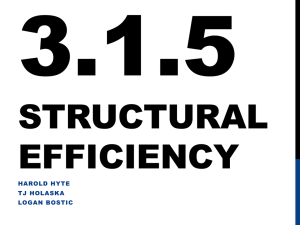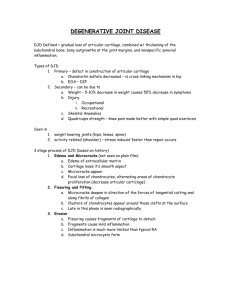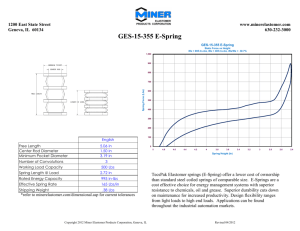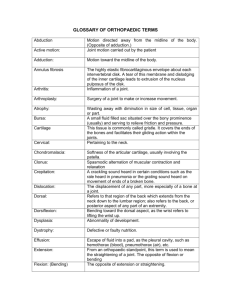Chapter 3
advertisement
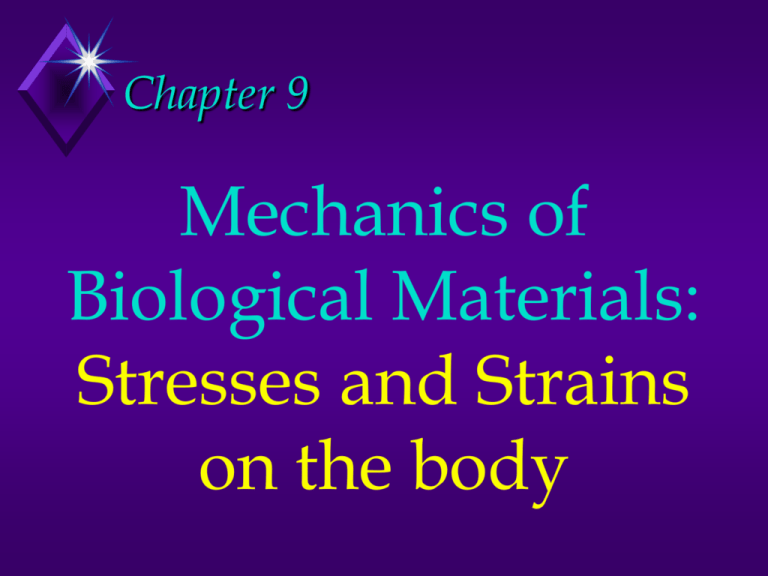
Chapter 9 Mechanics of Biological Materials: Stresses and Strains on the body Loads The external forces that act on the body impose loads that affect the internal structures of the body. Mechanics Science concerned with the effects of forces acting on objects (body) Rigid-body mechanics Deformable body mechanics Fluid mechanics Relativistic mechanics Quantum mechanics Rigid Body Mechanics Acceptable for analyzing gross movements Assumptions body does not deform by bending, stretching or compressing segments are rigid links joined by frictionless hinges at joints Free body diagram Free body diagram - sketch that shows a defined system in isolation with all the force vectors acting on the system defined system: the body of interest vector: arrow to represent a force length: size of the force tip: indicates direction location: point of application Pressure or Mechanical Stress Mechanical stress (pressure) is the internal force divided by the crosssectional area of the surface on which the internal force acts. Pressure (P = F/a) Pressure - is the force per unit area. When forces are sustained by the human body, the smaller the area over which the force is distributed, the greater the likelihood of injury. Scalpel vs butter knife example Stiletto heel vs moccasin Pressure or Mechanical Stress Force per unit area. P = Force / area For a similar force increase area==> decrease area==> For a similar area increase force==> decrease force==> Bite Force Human female = 81 lbs Human male = 127 lbs Humans have 32 teeth Bite Force Dogs Pit Bull = 235 lbs German Shepherd = 238 lbs Rottweiller = 328 lbs Wild African Dogs = 317 lbs Bite Force Wild Animals African Lion = 691 lbs Great White Shark = 669 lbs Hyena = 1000 lbs Alligator snapping turtle = 1004 lbs 16 ft Nile Crocodile = 2500 lbs Pressure (Comfy & Cozy) A little uncomfortable Somewhat painful. Graphic of stress pattern when walking http://www.uni-essen.de/%7Eqpd800/anim1.html Units of Stress or Pressure Metric system (SI) N/m2 Mpa English (one Pa (Pascal)) = Mega Pascal (106 Pa) system lbs/in2 or psi) (pounds per square inch PatelloFemoral Stress during the squat Degrees Knee Flexion 20 30 50 90 PF Contact Area (cm^2) 2.6 3.1 3.9 PF Force (N) 238 615 4186 Area: Huberti & Hayes (1984) PF Force: Escamilla et al, unpublished data PF Stress (Mpa) 0.92 7.00 10.21 Calculations What is the stress on the knee when a 1000N force is exerted over a 4.0 cm2 area? Knee Stress Why are deep knee bends, squats below 90 degrees, and “duck walks” contraindicated? Three principle stresses Two are axial normal stress or longitudinal stress One is transverse Mechanical loads on the human body: Compression Tension Shear Compression pressing or squeezing force directed axially through a body Compressive Loading Example Tension pulling or stretching force directed axially through a body Tension On the rack Shear Applied force tends to slide the molecules across each other. Shear Blow to the side Mechanical loads on the human body: Bending - asymmetric loading produces tension on one side of the longitudinal axis and compression on the other side Axial - directed along the longitudinal axis of a body. Mechanical loads Torsion load producing twisting of a body around its longitudinal axis. Combined loading Simultaneous action of more than one of the pure forms of loading. Load and Response Stress force per unit area Strain deformation amount of deformation divided by original length Generic Stress-Strain Relationship Elastic Limit (Yield Point) Strain (deformation) Mechanical Strength The strength of a material has to do with the maximum stress (or strain) the material is able to withstand before failure. Toughness Mechanically, toughness is the ability to absorb energy and not fail (or before failure). Strain Strain is the quantification of the deformation of a material Linear Strain Occurs as a result of a change in the object’s length. Shear Strain Occurs with a change in orientation of adjacent molecules as a result of these molecules slipping past each other. Instron Measuring stress and strain in biological materials Mechanical Properties of the Musculoskeletal System Age and activity level affect the mechanical properties of all connective tissue. Bone Bones are strongest in compression and weakest in shear. Cartilage Three kinds: Hyaline cartilage (articular cartilage) covers ends of long bones in joints Cartilage Fibrous cartilage - found within some joint cavities (the menisci of the knee), the intervertebral discs, at the edges of some joint cavities, and at the insertions of tendons and ligaments into bones. Cartilage Elastic cartilage - found in the external ear and tip of the nose. Cartilage Cartilage is able to withstand compressive, tensile, and shear loads. Articular cartilage transmits the compressive loads from bone to bone at joints Cartilage Articular cartilage - serves two purposes: Spreads loads over a wide area so that the amount of stress at any contact point between the bones is reduced. It allows movement of the articulating bones at the joint with minimal friction and wear. Cartilage Function may include distribution of loads over the joint surfaces, improvement of the fit of the articulating surfaces, limitation of translation or slip of one bone with respect to another, protection of the periphery of the articulation, lubrication, and shock absorption. Articular Connective Tissue: Tendons - connect muscles to bones. Ligaments - connect bone to bone. Both are composed primarily of collagen and elastin fibers. Do not have the ability to contract, but they are slightly extensible. Articular Connective Tissue: These tissues are elastic and will return to their original length after being stretched, unless they are stretched beyond their elastic limits. Can only be fixed with surgery. Ligaments and Tendons Ligaments, tendons, and cartilage all have similarly shaped stress-strain curves due to their collagenous composition. Ligaments and Tendons Under low stresses, these materials are pliant, but as the stresses increase past a certain threshold, they become much stiffer. Muscle The mechanical properties of muscle are not as easily examined due to its contractile ability. Muscle The ultimate stress of muscle is less that that of tendon, ligament, or bone, whereas its failure strain is much greater.




